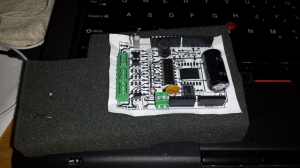Designing Printed Circuit Boards (PCBs) is not as hard as it seems. A couple of years ago I got into embedded electronics as a hobby and since then I have designed a couple of boards for simple projects. I used CadSoft’s EAGLE PCB design software. The learning curve was (is, because I think I am still learning) steep but there are good tutorials to be found on-line, including a tutorial from CadSoft itself.
Obviously, after designing a board you will want to manufacture it, either by yourself or by paying someone to do it cialis 10mg bestellen. In either case, catching errors in the design before the board is manufactured will prevent frustrations after you have the board in your hands and notice during testing that it does not work because of some problem like incorrect part footprints, incorrect board size, etc.
What I have done a couple of times to try to catch problems before it is too late has been to make a 1:1 copy of the board, glue it to some material that allows to stick real parts to it, and then lay out the parts on top, as shown in the following picture:
Nothing earth-shattering but it definitely has been useful and saved me a couple of times.

